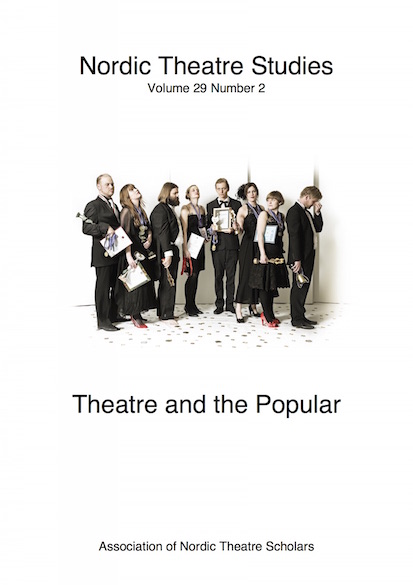The Revitalization of Popular Theatre Forms in Contemporary Performance: The Case of Post-Soviet Lithuanian Theatre
DOI:
https://doi.org/10.7146/nts.v29i2.104608Keywords:
Post-Soviet Lithuanian theatre, Šėpa theatre, Miraklis theatre, Mime, PuppetryAbstract
The article examines the use of historical popular theatre forms in contemporary performance and analyses how historical popular theatre forms are revitalized in contemporary theatre.
The first part of the article addresses the phenomena of popular theatre in general. Referring to the insights on this topic by such theatre scholars as D. Mayer (1972), P. Pavis (1998), T. Grammatas (2013) the article addresses the problem of the definition of popular theatre and discusses what are the major characteristics that make the forms of popular theatre into the source of creative renewal and artistic inspiration.
The second part of the article analyses how historical popular theatre practices (such as pantomime, mime, puppetry or shadow plays) have been used by post-Soviet Lithuanian theatre artists – namely, director Gintaras Varnas at Šėpa theatre and director Vega Vaičiūnaitė at Miraklis theatre – as a stimulus to renew theatrical language and to foster new relationship with theatre audiences. The examples of both companies demonstrate that in spite of the conventional genre restrictions, the historical forms of popular theatre are not treated as an unquestionable museum relic, but rather as a means to create a live and immediate contact with a contemporary audience through universal historical forms.References
di Blasi, Johanna. 1998. “Pro memoria Šv. Stepono 7.” Šiaurės Atėnai 28.11, 7.
Brook, Peter. 1968. The Empty Space. New York: Touchstone.
Charles, David. 2005. “A New Paradigm of Popular Play: Playback as Bakhtin-ian Novelistic Theatre.” Centre for Playback Theatre: Building Communities of Understanding. http://www.playbacktheatre.org/wp-content/uploads/2010/04/Ch arles-ANewParadigmOfPopularPlayPlayback.pdf (16.8.2016).
Gasparavičius, Dainius. 2000. “Naujų raiškos priemonių ieškojimo kryptys šiuo-laikiniame Lietuvos teatre. Aplinkos teatro trupė “Miraklis”.” In B. Vaškelis, R. Skenedelienė, and A. Guobys (eds.). Teatrologiniai eskizai. Kaunas: Vytauto Didžiojo universitetas, 43-74.
Grammatas, Theodoros. 2013. “‘Popular’ and ‘Highbrow’ in the Theatre: Cultural Interaction and Osmosis between the Genres.” Antropologia e Teatro 4, 1-17.
Jauniškis, Vaidas. 1997. “Vegos knygos: ‘Audra’ ir Užupis.” Lietuvos rytas 15.8., 30.
Jurkowski, Henryk, and Penny Francis. 1996. A History of European Puppetry: From its Origins to the End of the XIXth Century 1. Lewiston: Edwin Mellen Press.
“Kas yra alternatyvus teatras?” - Vegą Vaičiūnaitę kalbina Ridas Viskauskas, interview in Literatūra ir menas, 2.10.1999, 9.
“Kiekvienas spektaklis - kaip stebuklas” - Vegą Vaičiūnaitę kalbina Ridas Vis-kauskas, interview in Literatūra ir menas, 28.8.1999, 1, 8.
Koršunovas, Oskaras. 2009. “Teatras man - pažinimo instrumentas.” Bernardi-nai.lt, 11.9. http://www.bernardinai.lt/straipsnis/-/2615 (20.8.2016).
Lewitter, Lucian Ryszard. 1950. “The Polish ‘Szopka’.” The Slavonic and East European Review 29:72, 77-85.
Marcinkevičiūtė, Ramunė. 2006. “Iš lietuvių teatro režisūros istorijos: XX a. 8-ojo ir 9-ojo dešimtmečių teatro praktikos koordinatės.” Menotyra 45:4, 32-38.
Mayer, David. “Towards a Definition of Popular Theatre.” In David Mayer and Kenneth Richards (eds.). Western Popular Theatre. London: Methuen, 257-277.
Mayer, David, and Kenneth Richards (eds.). Western Popular Theatre: The Pro-ceedings of a Symposium sponsored by the University of Manchester. London: Methuen.
Mažeikienė, Rūta. 2010. “Animating Genius Loci: Historical Memory and Site-Specific Performance.” Art History and Criticism 6, 88-93.
McCormik, John, and Bennie Pratasik. 1998. Popular Puppet Theatre in Eu-rope, 1800-1914. Cambridge: Cambridge University Press.
Merkevičiūtė, Austėja (ed.). 2013. Vegos Vaičiūnaitės Miraklis. Vilnius: Kultūros barai.
Oginskaitė, Rūta. 1989. “Juokas pro...” Kultūros barai 6, 38-39.
Oginskaitė, Rūta. 1990. “Pasikikendami.” Literatūra ir menas 16.6., 7.
Pavis, Patrice. 1998. Dictionary of the Theatre: Terms, Concepts, and Analysis. Toronto & Buffalo: University of Toronto Press.
Prendergast, Monika and Saxton, Juliana (eds.). 2009. Applied Theatre: International Case Studies and Challenges for Practice. Bristol & Chicago: Intellect.
Šabasevičius, Helmutas (ed.). 2009. Gintaro Varno teatras. Pokalbiai, straisniai, re¬cenzijos / 1989-2009. Vilnius: Kultūros filosofijos ir meno institutas.
Saltz, David Z. 2008. “Editorial Comment: Popular Culture and Theatre History.” Theatre Journal 60:4, 1-3.
Schechner, Richard. 2013. Performance Studies: An Introduction 3rd edition. London & New York: Routledge.
Schechter, Joel. 2003. “Back to the Popular Source.” In Joel Schechter (ed.). Popular Theatre: A Sourcebook. London & New York: Routledge.
Varnas, Gintaras. 2006. “Kūrybos be darbo nėra.” Kamane.lt. http://www.kamane.lt/layout/set/print/Spaudos-atgarsiai/2006-metai/Sausis/Teatras/GINTARAS-VARNAS-KURYBOS-BE-DARBO-NERA (22.6.2016).
Downloads
Published
How to Cite
Issue
Section
License
The copyright belongs to the authors and Nordic Theatre Studies. Users can use, reuse and build upon the material published in the journal but only for non-commercial purposes. Users are allowed to link to the files, download the files, distribute the files on a local network (preferably by links), upload the files to local repositories if their institutions require them to do so, but not republish the files without proper agreements with the journal and the author.

